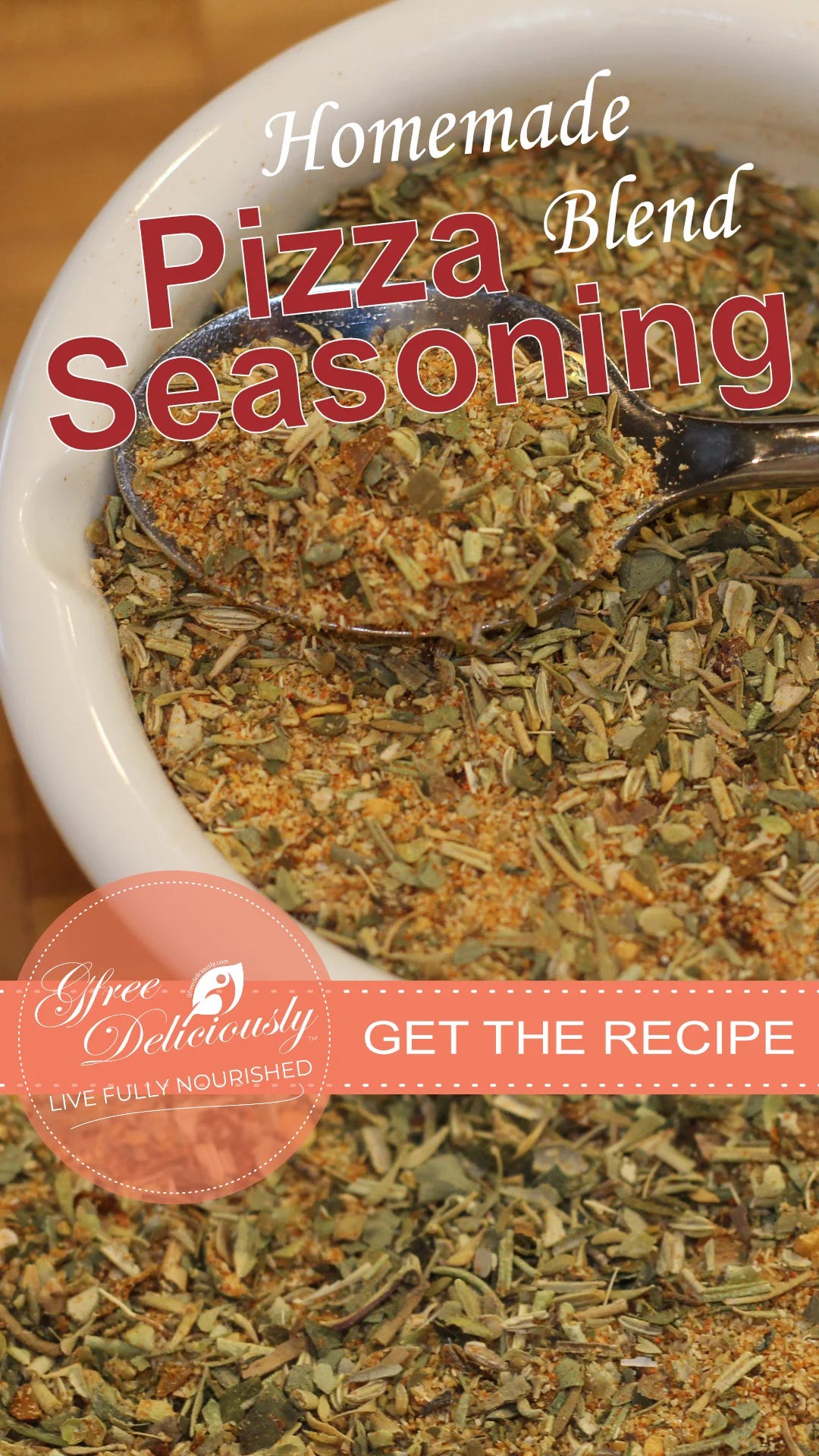A Pizza Seasoning Blend from Scratch
Pizza Part 1 + The Aromatic Foundation, Adding Depth and Complexity, Flavor Enhancers, Creating Your Blend, & Tips for Using Your Pizza Seasoning Blend...
The Fundamental Components of a Delicious Homemade Pizza Seasoning Blend
There's something undeniably satisfying about making homemade pizza. Every element plays a critical role in the final dish, from the dough to the sauce and toppings. However, the seasoning blend is one often overlooked component that can elevate your pizza from good to exceptional. A well-crafted pizza seasoning adds depth, aroma, and an intricate flavor profile that complements the other ingredients beautifully. In this Live Fully Nourished installment, we will explore the fundamental components of a delicious homemade pizza seasoning blend and how to create one that tantalizes your taste buds.
The Joy of Crafting Pizza Seasoning from Scratch
From my college days of working at Pizza Hut, I've been in love with everything about pizza. That restaurant experience, in so many ways, ignited my delight in turning simple ingredients into a masterpiece.
Fast forward to today, that same masterful delight comes from new kitchen adventures, like when making pizza seasoning from scratch. It's a prime example of transformative kitchen alchemy. As pizza lovers know, the magic of a perfect pizza lies in more than just the crust and toppings. It's also the symphony of flavors that season the dish. A well-crafted seasoning blend can elevate a humble pizza into a culinary creation that tantalizes the taste buds. You could say that the proof is in the pie, thus fueling my passion for homemade cuisine.
If you've not made it before, creating a homemade pizza seasoning allows for loads of customization that store-bought alternatives can't match. You can tailor the blend to suit your palate by hand-selecting each herb and spice—anywhere from a zesty emphasis on garlic and oregano to a bold infusion of crushed red pepper and rosemary. It's a chance to infuse your cooking with individuality and creativity that's both practical and personal. Moreover, the fresh aroma of herbs combined in your kitchen serves as a sensory experience that enhances the overall cooking ritual.
Still beyond flavor, making pizza seasoning from scratch promotes a deeper understanding of the ingredients. You gain insight into the origins and characteristics of each herb, a journey that fosters appreciation and respect for the craft of cooking. Ultimately, this homemade approach is far healthier than many commercial blends, often laden with anti-caking agents, preservatives, and artificial flavors. By creating your seasoning at home, you control the quality and freshness of the ingredients, thus ensuring that every sprinkle bursts with authentic taste.
So please grab your whisk and prepare to enter the world of homemade pizza seasoning, with endless possibilities.
How to get this recipe:
You can access the Homemade Pizza Seasoning Blend digital recipe card on GfreeDeliciously.com. Once there, you can easily adjust the servings, add ingredients to your grocery list, read about the equipment and resource recommendations we’ve used to make it, and quickly print, pin, or favorite it!
Keep scrolling 👇 for a quick summary of the recipe below. 👩🍳
As an added benefit to paid subscribers, you can download a 3-ring-binder-ready printable recipe PDF. Find it at the end of this post to print or save for building a cookbook of all your favorites!
Sign Up & Register
Dried Herbs: The Aromatic Foundation
Oregano
Oregano is arguably the star herb in most pizza seasonings. Its robust, slightly bitter flavor pairs wonderfully with tomatoes and cheese, enhancing the overall taste of the pizza. Use dried oregano as the backbone of your blend.
Basil
Another classic herb associated with Italian cuisine, basil, adds a sweet, slightly peppery element. Fresh basil is delightful, but dried basil offers a concentrated flavor perfect for pizza when making a seasoning blend.
Fennel
Fennel is versatile and widely used in various ways—as garnish, fresh fronds, or finely chopped and sprinkled over pizza. Many pizza enthusiasts prefer roasting the bulbs before adding them as toppings to intensify their taste. We use fennel seeds for this blend, which boast a sweet, nutty flavor to enhance the seasoning.
Thyme
Thyme brings a subtle earthiness often found in Mediterranean cuisine. Its delicate aroma complements the other herbaceous notes without overpowering them, making it an excellent addition to your pizza seasoning.
Rosemary
While not always found in traditional pizza blends, rosemary's fragrant pine-like flavor can add a unique twist to your seasoning. Use it sparingly, as its potency can overpower other flavors, but a hint can elevate the overall profile of your pizza.
Spices: Adding Depth and Complexity
Garlic Powder
Garlic is an essential flavor in most savory dishes, including pizza. Garlic powder is a fantastic addition to a seasoning mix, providing a robust garlic flavor without needing fresh ingredients. Its convenient shelf-stability makes it a go-to for home cooks.
Onion Powder
Often paired with garlic, onion powder adds sweetness and depth to the seasoning blend. It enhances the overall flavor profile without the texture of fresh onion, making it ideal for a dry mix.
Paprika
Paprika is a spice derived from dried and ground sweet and hot peppers. It is commonly used in Hungarian and Spanish dishes and is favored to add to pizza before or after baking. Before cooking, many pizza enthusiasts enjoy sprinkling paprika on their toppings, like meats or vegetables. Paprika can enhance flavor in various ways. To simplify everything, we effortlessly mix it in to craft this distinctive pizza blend.
Black Pepper
Freshly ground black pepper adds a subtle bite and complexity to your blend. It enhances other flavors without being overpowering and rounds out your seasoning perfectly.
Crushed Red Pepper Flakes
Crushed red pepper flakes are a must-have for those who enjoy a kick of heat. They bring a level of spice that can be adjusted based on personal preference, allowing you to customize your pizza to your desired level of warmth.
Cayenne
For meat-heavy pizzas, like pepperoni or sausage, adding a small amount of cayenne in the seasoning will add a bit of sharp, distinct heat, depth, and a little kick to the taste.
Additional Flavor Enhancers
Parmesan Cheese Powder
Consider adding Parmesan cheese powder to your seasoning blend to introduce a savory, umami element. This ingredient contributes a rich flavor reminiscent of freshly grated cheese. Just be cautious with the quantity, as it can make the blend too salty.
Sugar
A pinch of sugar can balance out the acidity in tomato-based sauces and enhance the flavor of the seasoning blend. To add this sweeter touch, use granulated sugar or granulated garlic.
Salt
Salt is essential for enhancing flavor. Although it typically seasons food separately, including it in the pizza seasoning allows for even distribution in the seasoning and across the pizza's surface. Opt for kosher salt or sea salt for a coarser texture.
Tips for Using Your Pizza Seasoning Blend
Application: Sprinkle your pizza seasoning over the sauce before adding cheese and toppings for an even flavor distribution.
Experiment: Feel free to tweak the ratios or add other spices you enjoy, such as smoked paprika or dried parsley, to create a blend that reflects your culinary personality.
Storage: For optimal freshness, combine your herbs and spices before using them or make smaller batches to retain potency.
💭 Final thoughts before you get started...
Crafting your homemade pizza seasoning blend opens up a world of flavor potential, enhancing your culinary creations without overpowering them. By understanding and selecting the right components—dried herbs, spices, and flavor enhancers—you can create a seasoning that brings out the best in every slice. So, roll up those sleeves, gather your ingredients, and why not get started on your journey to pizza perfection?
Thanks for stopping by. Have a happy time blending!
Creating Your Blend: The Perfect Ratio
Gluten-Free + Healthy Choices, Low-Carb, Low-Fat, Sodium Smart, Sugar-Free
Once you have gathered the fundamental components, it's time to create your personalized pizza seasoning blend. Following are the ratios for what I use to get you started:
Ingredients
2 tablespoons dried Oregano
1 tablespoon dried Basil
1 tablespoon Garlic Powder
1 tablespoon Onion Powder
2 ½ teaspoons Fennel Seeds, ground [1]
2 teaspoons dried Thyme
2 teaspoons dried Rosemary, crushed [2]
1 teaspoon Paprika
½ teaspoon Black Pepper
½ teaspoon Red Pepper Flakes
¼ teaspoon Cayenne Pepper
Instructions
Grind the fennel seeds and crush the dried rosemary using a clean, dry mortar and pestle or one of the alternative methods as described in the kitchen notes.
Add all the seasoning ingredients in a small bowl and whisk to combine, mixing well to ensure they become evenly distributed.
Store the homemade pizza seasoning blend in an airtight glass jar or a BPA-free plastic container with a tightly sealed lid. Label it with the seasoning's name, the date you made it, and any additional notes you may find helpful. Store it in a cool, dry, dark place for up to six months.
Kitchen Notes:
You can easily double this recipe. Feel free to adjust the ingredients, adding or eliminating any to suit your tastes.
Need a quick and easy homemade pizza sauce recipe? This gluten-free, sodium-free homemade pizza seasoning blend creates a tasty sauce that requires only one 15-ounce can of tomato sauce and six ounces (one can) of tomato paste. Our quick and easy no-cook pizza sauce recipe yields a rich, flavorful, saucy base that will elevate any pizza!
[1] Grind the fennel seeds using a clean, dry mortar and pestle. Use the pestle to grind the seeds into a fine powder, applying gentle but firm pressure to release the oils and flavors. You can also use an electric coffee or spice grinder for this purpose.
[2] Crushing the dried rosemary will break it up to release the aromatic oils and flavors of this dried herb, making it perfect for further cooking and seasoning. Start by placing the dried leaves in a clean, dry mortar and pestle. As you did above, apply gentle but firm pressure to lightly crush and break up the leaves. You can also use an electric coffee or spice grinder. Pulse the rosemary in the grinder until the leaves are evenly textured, rather than letting it run continuously to avoid turning it into a fine powder.
Alternatively, you could crush the dried rosemary leaves using a plastic zipper bag and a rolling pin. Place the dried rosemary in the bag, flatten it to remove as much air as possible, zip the bag closed, and roll the rolling pin over it several times until you achieve the desired texture.
Enjoy the Recipe! Scroll to the end for the downloadable PDF, which you can print and save to your recipe binder.
L♥VE this recipe? Have you tweaked it to be over-the-top delicious? Have a question? Please let everyone know in the comments below! 😉 It’s super helpful for other readers and me.
Are you looking for more recipes?
Find similar recipes to this one in…
Download the PDF printable 3-ring binder formatted page below.
Print, then punch to fit in your 3-ring binder, and file the recipe by name, alphabetically in the tabbed section:
Keep reading with a 7-day free trial
Subscribe to Live Fully Nourished @GfreeDeliciously to keep reading this post and get 7 days of free access to the full post archives.














